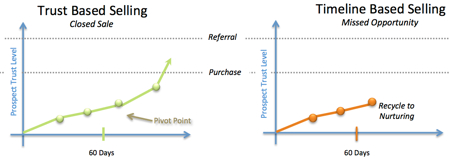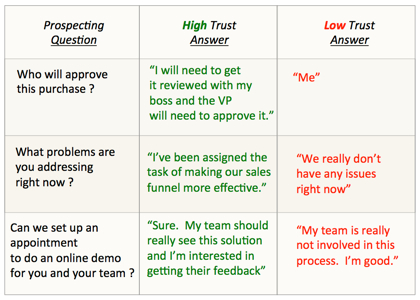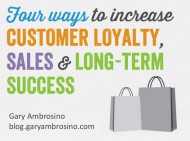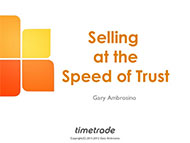Every great sales rep intuitively senses the pivot point momentwhen they’ve built enough trust in a prospect that they know the deal will close. You know who these reps are – – they are the top performers on your team
DO YOU QUALIFY LEADS BY TRUST LEVEL OR TIMELINE ?
How about your sales team – – do you make this successful practice by making it a systematic part of a structured sales management process ? Or is your sales team running on timeline-based prospecting . Here’s a checklist to help answer this question:
- Leads are measured by how they progress within a pre-defined schedule.
- Salesforce is programmed for follow-ups based on time intervals
- Leads are sent to nurturing after a certain time period has elapsed
- Conversion rates in the funnel are low (See an article on the funnel
If you answered “yes” to any of these questions, you’re using traditional timeline-based prospecting.
MEASURE PROGRESS BY TRUST LEVEL NOT FUNNEL VELOCITY
Timeline prospect management can create a hit-or-miss syndrome in the funnel. The middle of the funnel can become a “death zone” for leads – – they either qualify-in during an arbitrarily defined period or get recycled into a nurturing cycle or dropped altogether. If the timeline doesn’t leave enough time for trust creation, it results in a missed opportunity:

In Trust-based prospecting, progress is measured in movement up the trust scale, not by time. On the other hand, a lot of sales and marketing managers I know use 60 to 90 days at the limit for outbound cycles or automated active nurturing in the sales automation system. When time is up, the lead is “recycled” to nurturing or ignored – – in other words, it enters a sales funnel “death zone” – – opportunity missed because of impatience caused by the urge to automate the sales process.
Instead, it’s better to structure the prospecting process as a series of Trust building steps. Like the chart above on the left, human nature is not linear and neither is establishing trust. So ignore the arbitrary time measurement and find a way to measure trust changes.
HOW TO MEASURE TRUST IN THE PROSPECTING PROCESS
So how do we measure trust ? There are whole books written on this topic. I did a poll of sales managers and found a some prevailing themes. First, here’s a simple trust quotient formula I like:
TRUST = CREDIBILITY + COMPETENCE
Credibility and competence are characteristics a sales rep can demonstrate during the sales cycle to move a prospect up the trust curve. Consensus from my informal poll of exceptional sales managers indicates there are two good ways to measure trust level with a sales prospect:
- Rate, depth, and honesty of the information that’s being exchanged
- The quality, content and openness of the dialog
I’ll cover trust-ranking and trust-classification of information tools in a future post. A good place to start looking at trust prospecting is to evaluate your current sales dialog. Here are a few examples that illustrate the point:
Expand on this list using your own sales prospecting questions that you know work well in your process. Use this chart as a framework and anticipate and write down the High Trust and Low Trust answers you’ve heard or would expect to hear. In addition to the content and vocabulary, the tone, and honestly level of the answers will also be key measures of trust.
These are a few of the principals to use in Trust-based Prospecting and can form the core on which you can build your own system. Remember, resist the urge to use timelines as the as the sole pacing item in determining what to do with leads.


